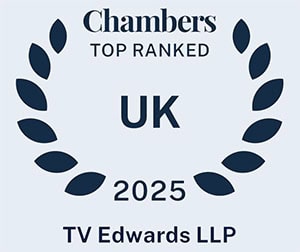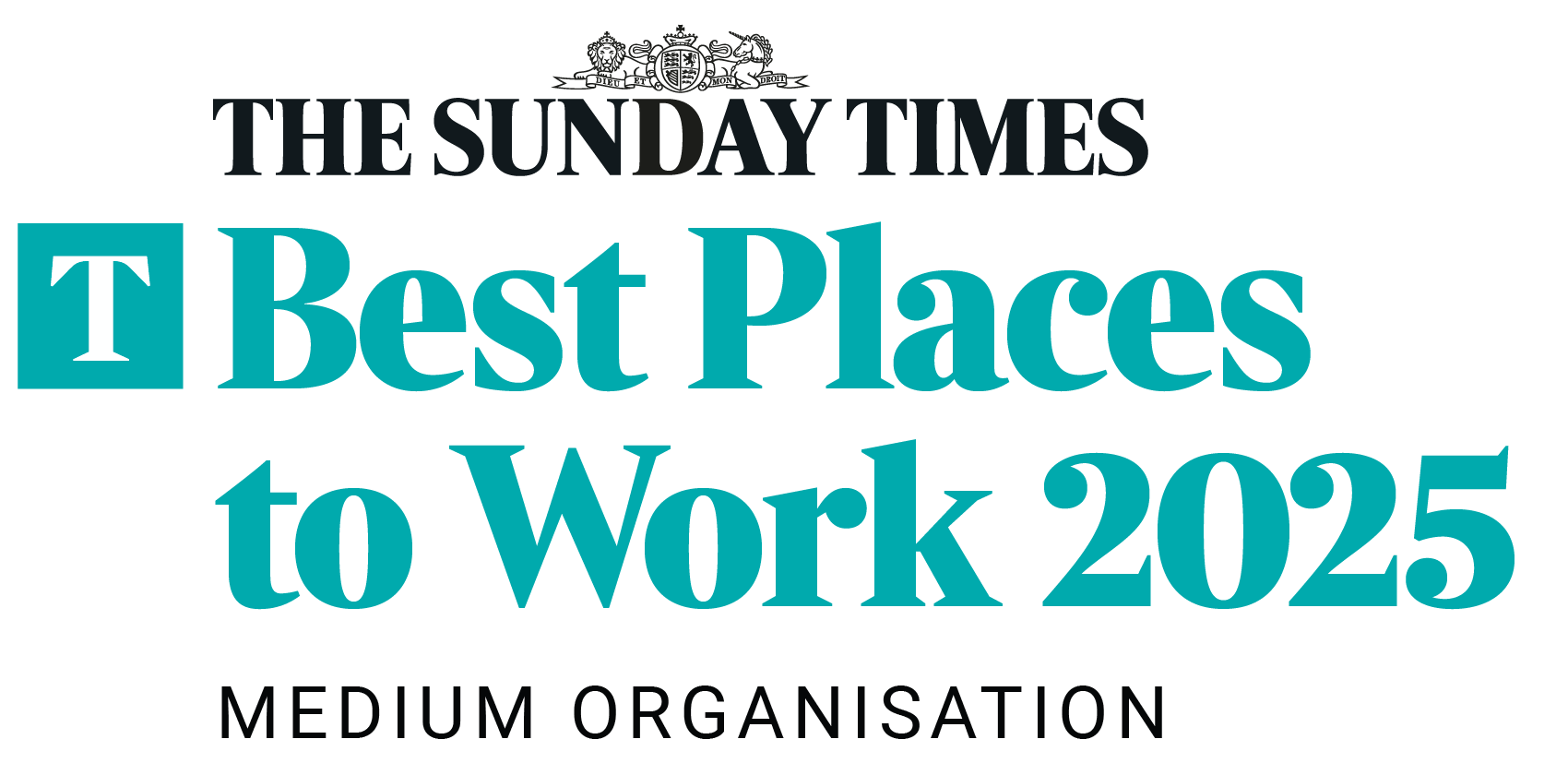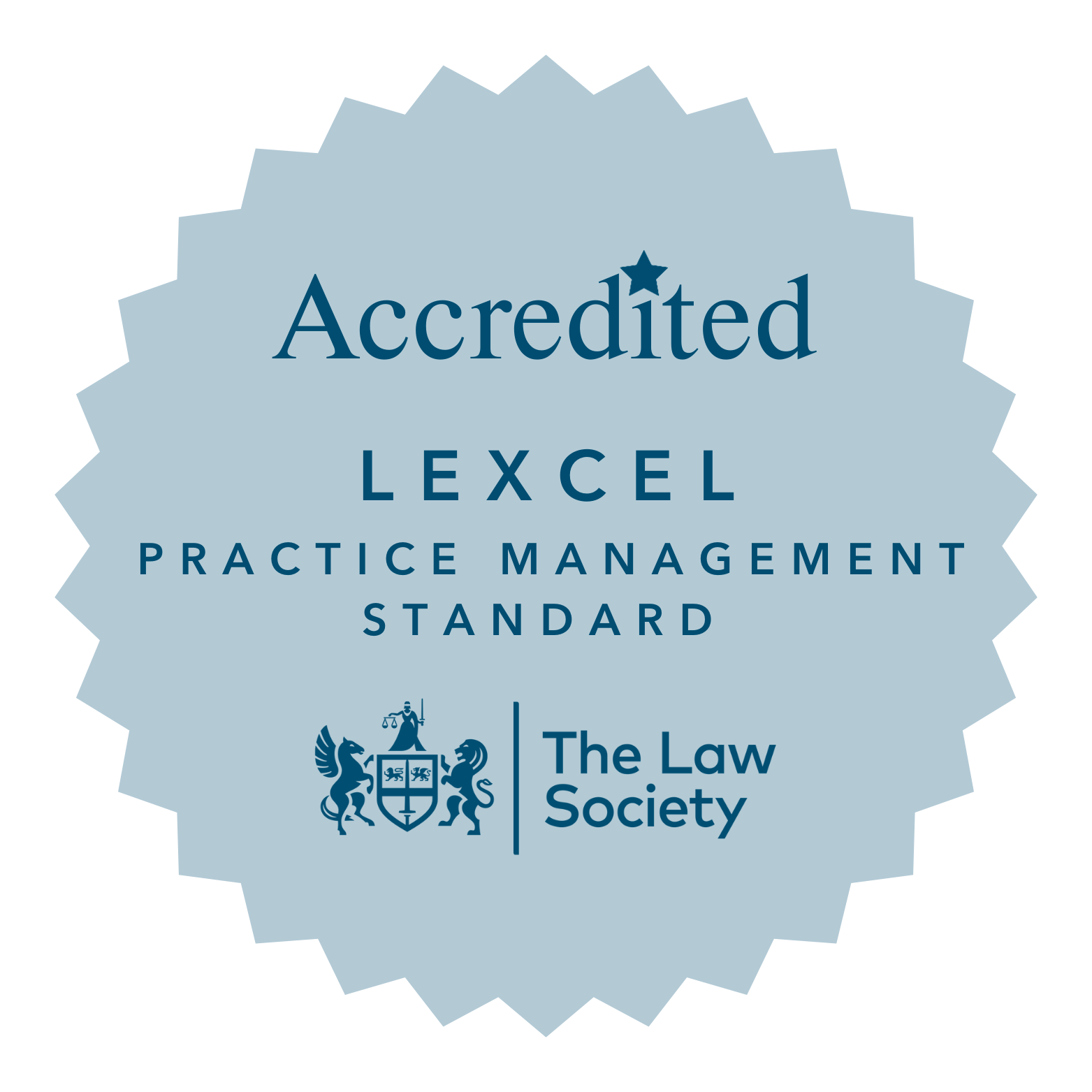
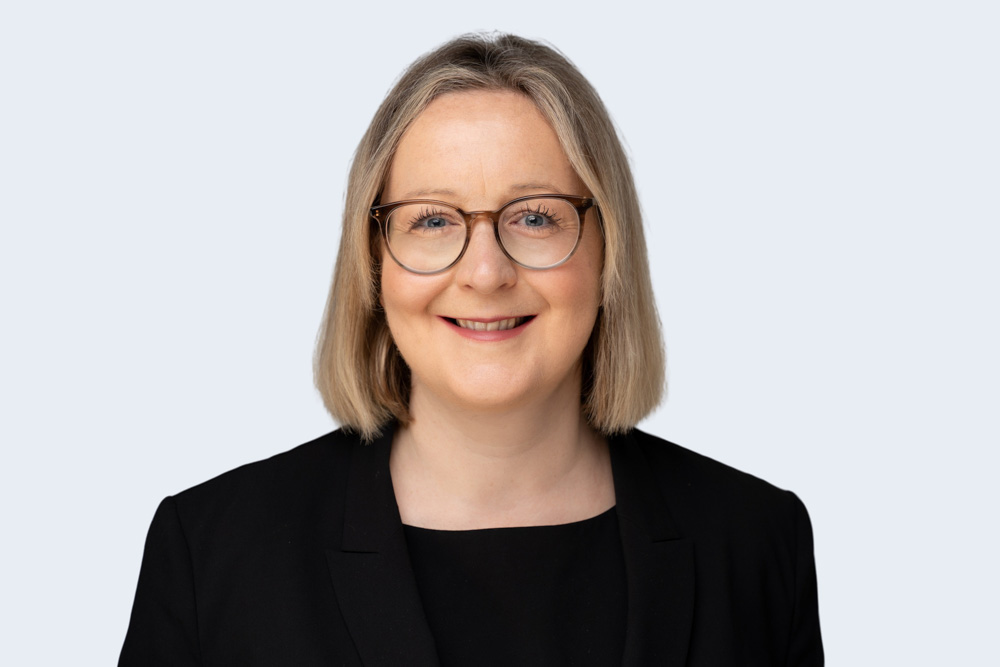
In December 2005 we celebrated the commencement of the Civil Partnerships Act 2004 and later that month the fact that unmarried couples including same sex couples were able to adopt jointly following the commencement of the Adoption and Children Act 2002.
On 6 April 2009 the parenthood provisions of the Human Fertilisation and Embryology Act 2008 came into force allowing a child to have two female parents from birth. The same act allowed same sex couples to apply for parental orders, thus allowing same sex couples to build their families through surrogacy.
Gay marriage was introduced in England and Wales by the Marriage (Same-Sex Couples) Act 2013 with the first same sex marriages taking place on 29 March 2014.
Summary of Key Legislative Changes:

Whilst each of these legislative changes were welcomed as long overdue, I wanted to look at the impact of these on family formations. To do this my research has explored changes in couples receiving fertility treatments, using surrogacy, as well as adopting.
The HFEA publishes UK statistics for IVF and donor insemination (‘DI’) treatment, storage, and donation.[i] The most recent statistics were published in May 2021. The Ministry of Justice publishes Family Court Statistics Quarterly, giving National Statistics on activity in the family courts of England and Wales.[ii] The two sets of statistics cover different geographical areas and do not include assisted reproduction taking placed outside of a HFEA licensed clinic.
Fertility treatment for female same sex couples in HFEA licensed clinics
The HFEA looks at patients and treatment cycles by partner type, which includes surrogates and distinguishes between IVF cycles and DI cycles. The data has become more accurate over time. In 2000 there was no partner type recorded in relation to 3,226 IVF patients, by 2007 no partner type was recorded for only 79 and this reduced to less than five in 2012.
I decided to look at how the patient demographic changed. For the purposes of analysis, I have excluded the patients where no partner type is recorded as well as those where surrogates are recorded. I combined IVF and DI patients.
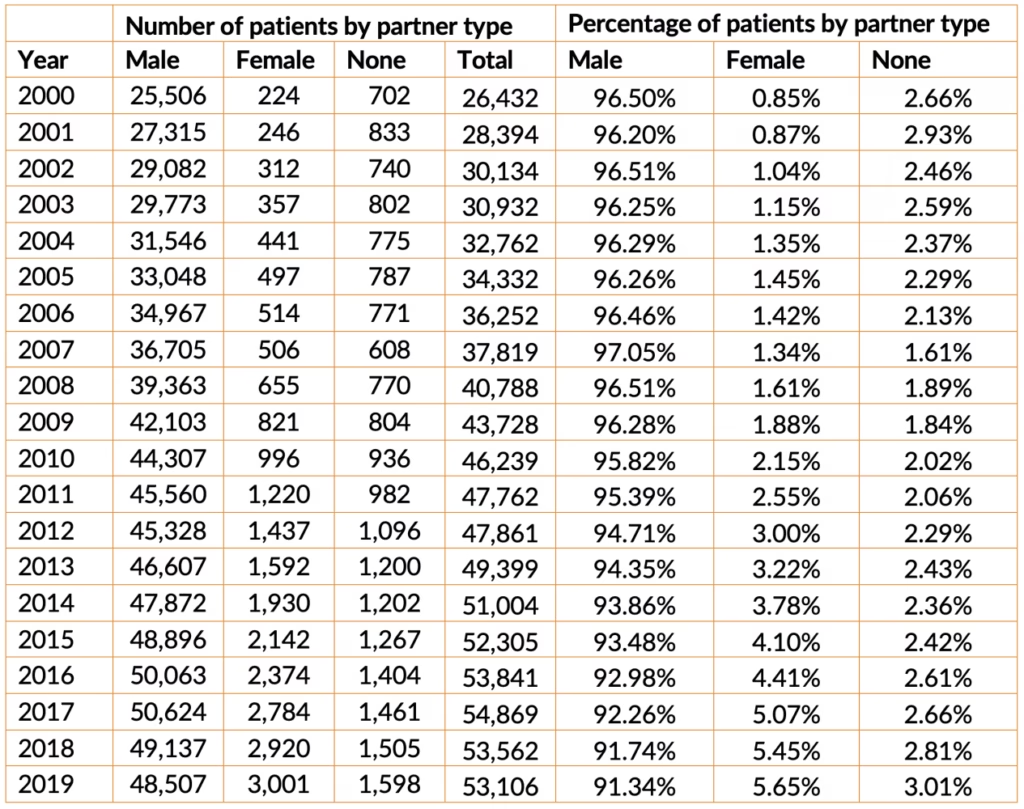
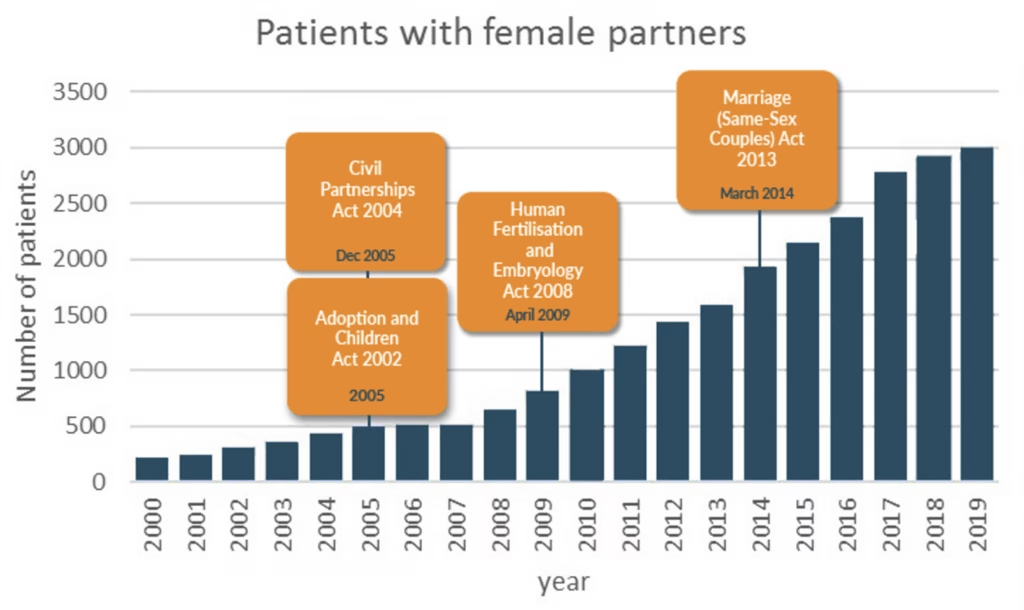
In 2008, before the implementation of the female parenthood provisions of the Human Fertilisation and Embryology Act 2008, there were 655 patients with female partners. This increased to 996 the first complete year following the implementation and since then, the number of patients with female partners has more than tripled to 3001with the percentage of patients with female partners rising from 1.61% to 5.65%.
Surrogacy
Whilst the HFEA has statistics about surrogacy patients and cycles, they do not record the gender of the intended parents.
In 2009 before the introduction of the surrogacy provisions of the Human Fertilisation and Embryology Act there were 139 surrogacy patients, in 2011 there were 159 surrogacy patients, this increased to 255 by 2019. The number of cycles for the same period were 166, 196 and 325.
Of course, treatment will not be successful in all cycles nor for all patients. It is also important to note that many intended parents travel abroad for surrogacy. Those arrangements will not be included in the HFEA statistics. Parental orders are necessary for intended parents to secure parentage following surrogacy arrangements. The Family Court Statistics show 117 parental orders were granted in England and Wales in 2011, rising to 444 in 2019.
The Law Commission and Scottish Law Commission consultation paper “Building families through surrogacy: a new law” records “information provided by CAFCASS dated 7 October 2015 in response to a Freedom of Information Request, which showed that, of 229 parental order applications made in 2014, 172 were made by opposite-sex couples, and 56 made by same-sex couples, compared to 92 opposite-sex couples and 1 same-sex couple in 2010”.
Adoption
In terms of adoption, the number of same sex couples adopting has also tripled over time.
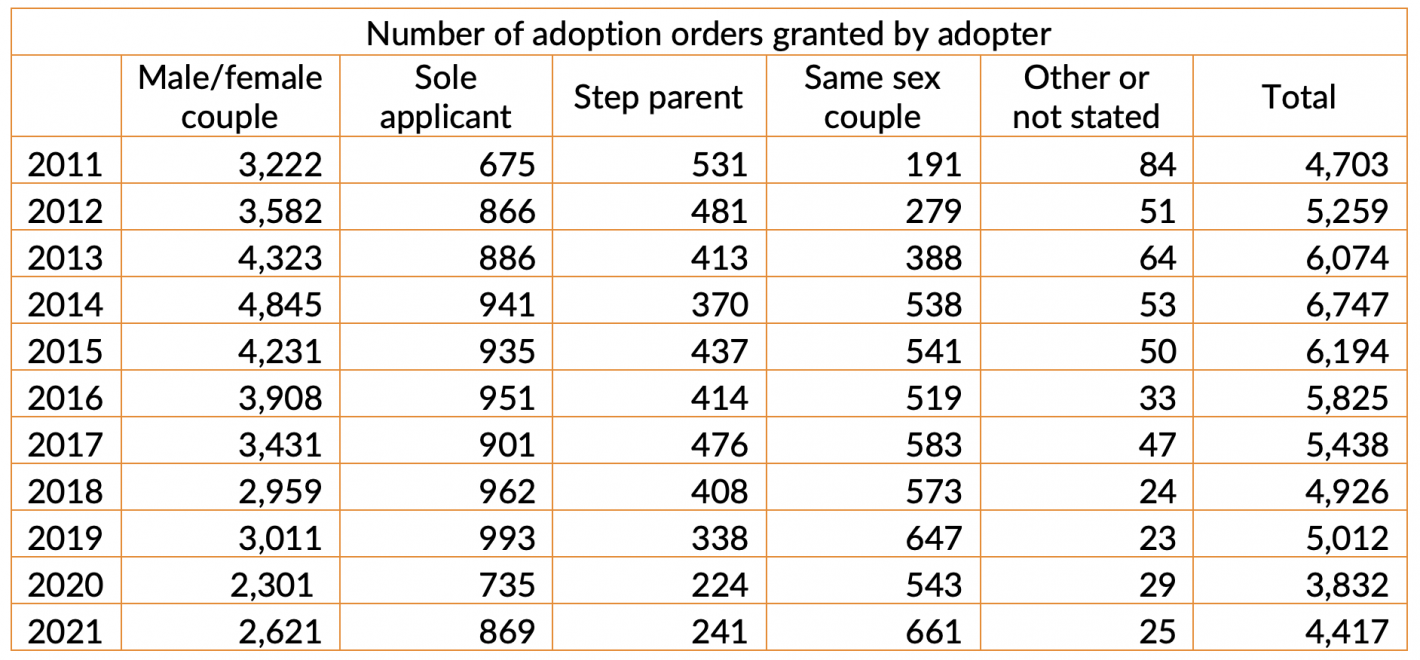
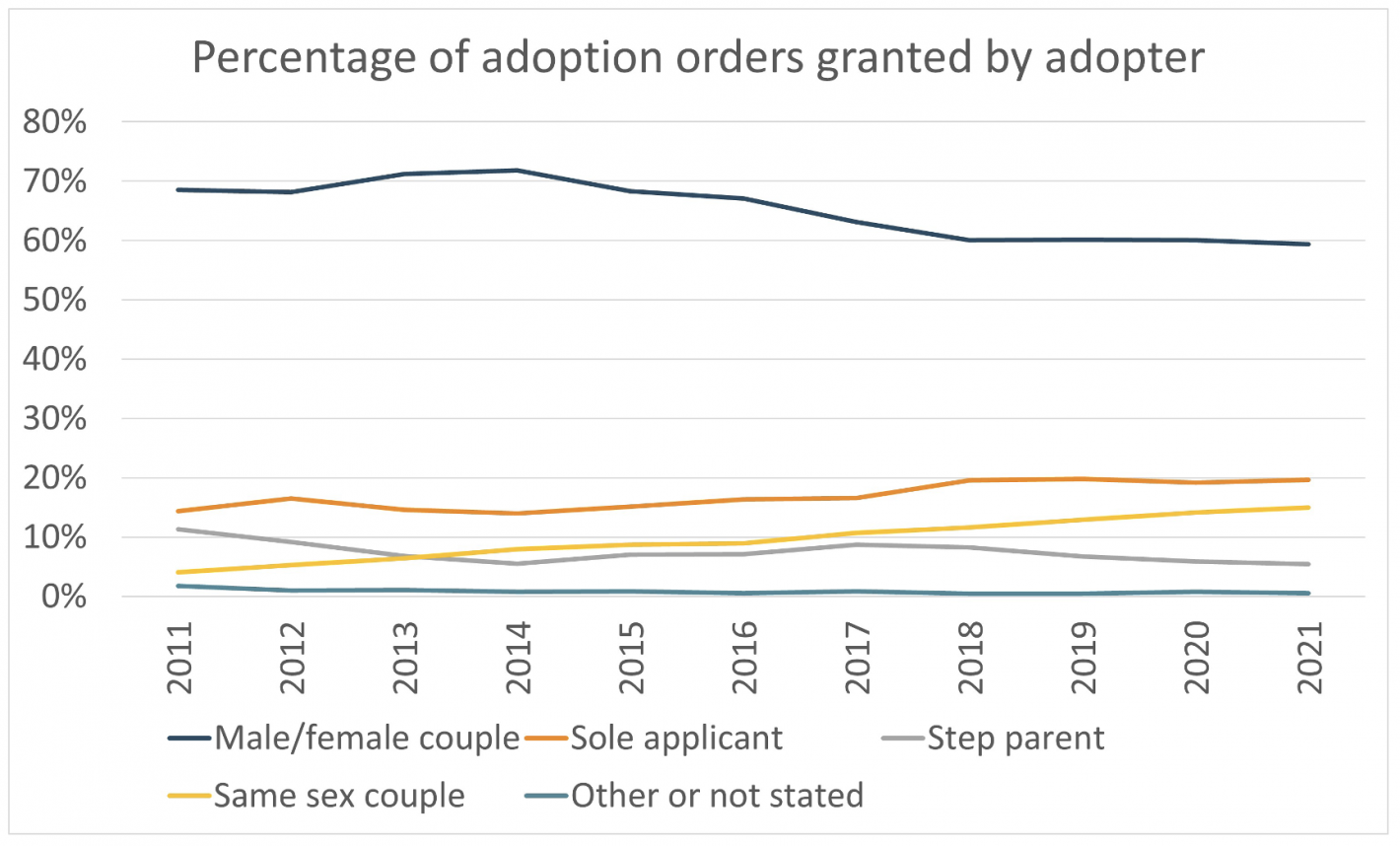
The adoption statistics include step parent adoptions where the gender of the couple is unknown, if these adoptions and those where the adopter was other or not stated, same sex couples accounted for 15.92% of adoptions in 2021, an increase from 4.67% in 2011.
ONS statistics[i] show that in 2019 the proportion of women identifying as heterosexual or straight was 93.9%, 1.1% of women identified as gay or lesbian and 1.6% as bisexual. Younger women are more likely to identity as being gay or lesbian, but the subsets of data do not easily correlate with the age of fertility patients. The HFEA statistics only identify the gender of a woman’s partner at the time of treatment and not their sexual orientation and so it is impossible to compare data accurately.
Pride Month and LGBT+ UK History
June is recognised as LGBT+ Pride Month, commemorating the Stonewall uprising of 1969 in the United States, a pivotal moment in the fight for LGBT+ rights.
In the United Kingdom, Pride has additional significance given the history of Section 28 of the Local Government Act 1988, which banned the promotion of homosexuality by local authorities. This legislation was not repealed until 2000 in Scotland and 2003 in England and Wales.
Today, Pride Month serves as both a celebration of LGBT+ rights and a reminder of the ongoing challenges that many in the community face.
It highlights the progress made through legislative change, such as the Civil Partnerships Act 2004, the Marriage (Same-Sex Couples) Act 2013, and reforms to adoption and surrogacy law. It also provides a platform to continue raising awareness of the legal rights of same-sex couples and same-sex family law, ensuring that equality is embedded both legally and socially.
For TV Edwards, acknowledging Pride Month is about more than celebration; it is about recognising the link between history, legislation, and lived experience. By reflecting on LGBT+ UK history alongside the continuing evolution of same-sex family law, we are reminded that progress in rights is not automatic but earned through advocacy, reform, and visibility.
Conclusion
The statistics outlined above evidence the real and positive impact arising from the legislative changes including: the commencement of the Civil Partnerships Act 2004, Adoption and Children Act 2002, the Human Fertilisation and Embryology Act 2008, and the Marriage (Same-Sex Couples) Act.
The research clearly illustrates that these key legislative changes have already led to significant increases in same sex couples expanding families, whether this is achieved using IVF, DI, surrogacy or adoption.
“It does not come as a surprise to me that we are edging towards a similar proportion of female same sex couples seeking to expand a family through fertility treatment as opposite sex couples with fertility issues. Whilst the figures for adoption remain comparatively small, same sex couples are now more likely to look to adoption. It is wonderful to see the continuing positive power of legal and societal changes. However, there is still room for improvement such as clinical commissioning groups reviewing and updating their funding policies. Official forms should be updated so that they do not simply refer to mother and father, they should enable a child’s parentage to be accurately recorded.” – Anest Mathias
How TV Edwards Can Help Same-Sex Couples
At TV Edwards, we combine our long history in family law with specialist expertise in LGBT+ rights and same-sex family law. Our Family Law solicitors advise on every aspect of same-sex couples’ legal rights, from civil partnerships and marriage to adoption, surrogacy, fertility law, and parental orders.
We understand that the legal framework can feel complex, particularly when navigating sensitive issues around family formation. Our role is to provide clarity, reassurance, and tailored advice that reflects both the law and the unique circumstances of each client.
Whether you are considering adoption, exploring fertility treatment, entering into a surrogacy arrangement, or simply want to know more about your rights, our team can guide you through every step. We are committed to ensuring that all families receive the recognition and protection they deserve.
About TV Edwards
TV Edwards was established in 1929 we enjoy a national reputation for delivering first-class legal services. Many of our lawyers are renowned legal experts; they train the profession, and they publish. Together our teams provide the legal support and expertise to help clients get resolution as quickly and as inexpensively as possible.
About Anest Mathias
Anest Mathias is TV Edward’s expert in fertility, surrogacy and modern parenting law. In her role as a lawyer, she advises heterosexual and same sex couples as well as individuals seeking to create their family.
Anest qualified as a solicitor in 2005 and advises married and unmarried couples on all aspects of private family law. She has a broad range of experience in divorce and separation including finances upon divorce, financial provision for unmarried couples and children and disputes as to the ownership of property.
[i]https://www.ons.gov.uk/peoplepopulationandcommunity/culturalidentity/sexuality/bulletins/sexualidentityuk/2020
[i] https://www.hfea.gov.uk/about-us/publications/research-and-data/fertility-treatment-2019-trends-and-figures/
[i] https://www.gov.uk/government/collections/family-court-statistics-quarterly

